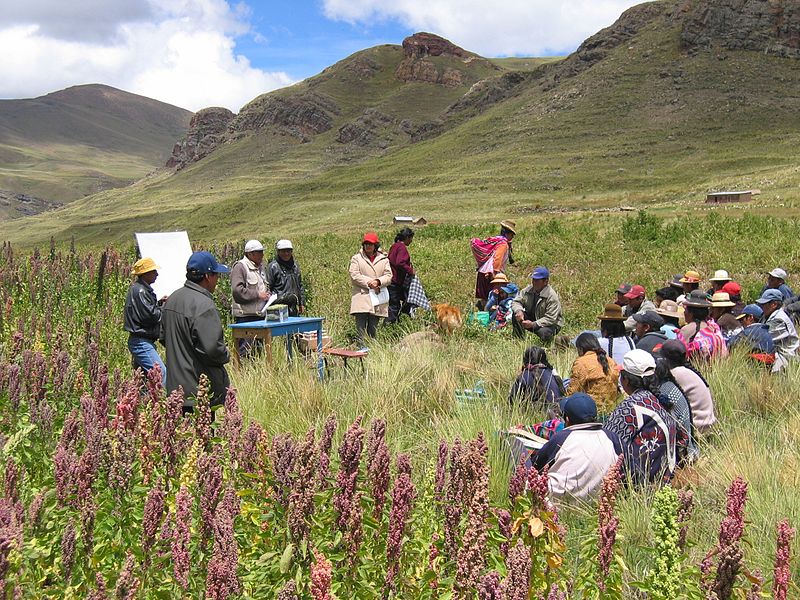Can you cut 1 Tonne of carbon pollution out of your life?
Take the challengeQuinoa, Quinoa, Quinoa. (Pronounced Keen-wah). It’s as fun a word to say as it is a food to eat. And by fun to eat I mean incredibly healthy.
Citizens of the Andean States (mainly Peru, Bolivia, and Argentina) have cultivated quinoa as a staple crop since the time of the Incas. In fact, it is referred to as "The Mother of All Grains" and has proven to be an agricultural gift for modern day farmers.
The farmers have long employed responsible agriculture and indigenous practices that encourage healthy soil and a fantastic crop yield. One such technique is Waru-Waru, which uses a combination of raised beds and surrounding ditches. This helps to ensure sufficient yield in times of drought, flooding or frost. In the ditches silt, algae, and sediment gather to create a thick nutrient-rich mud that is then added to the garden beds, directly reducing the need for commercial fertiliser. This practice prepares the vulnerable mountain region for climatic anomalies and keeps harmful chemicals away from the soil- an environmental win win. Another way the farmers have acted sustainably is their use of llamas to graze the areas surrounding quinoa farms. This keeps pests away and soil continually nutrient-rich.
As developed countries catch a taste for the superfood, demand has been exasperatingly increasing. At first, the rising interest was excellent for most of the people of the Andes Mountain region, but now it is changing their practices and likely causing stress in the communities.
There has also been much debate over rising quinoa price and the effect on the affordability for Andeans. The early fear was that by raising demand and prices of quinoa, developed countries were snatching a staple of the Andean diet and making it less affordable than pricier commodities, like chicken, for example. On the other hand, many Andean farmers are making more money than ever due to assimilation into co-op farming (businesses owned and controlled by the people who use them!). The farmers are able to decide their own price, leading to the continued improvement of their communities with the aid of fair-trade policies.
As quinoa continues its rise into fame, however, it begins to become extremely commodified. This causes major concern about potential outsourcing to cheaper countries, overworked Bolivian and Peruvian farmers turning towards unsustainability, and monoculture taking over a previously honored crop. All of these negatives would be detrimental to the progress made to the communities in the Andes. The soil, the climate, and the location near salt flats all express reasoning behind the fluffy, gorgeous yield of quinoa year after year. But few other crops would be able to succeed in such extreme conditions.
As countries race to replicate the growing process - Canada, USA, Kenya, India - few succeed... yet. A crop this successful could easily go the way of corn or soybean monoculture if left in the hands of nations that don't have the reverence or understanding of the mother grain.

How you can help keep these farming communities successful? Or children of farm families going to school? Or resist monocultures, their degradation to the environment, and their contribution to climate change? I've got a few ways...
1. Seek fair trade and socially responsible companies! Fair trade is simply the act of paying a fair price for your favourite goods to the producers abroad. It's a small amount of extra money for those of us living in privileged, developed countries, but for those who are receiving it, the reward is incredible. It provides community development that promotes concern for the environment, education, sustainable business models, and investments in healthcare and women.
2.Diversify your plate! There are many incredible superfoods (some even from quinoa's goosefoot family) including beets and swiss chard, spinach and lamb's quarter. Enjoy rich grains like freekah, farro, or chia. The more farmers you support, the more lives you are touching and the more health you are bringing to your body. It's a win-win-win.
3.Get to know your food system! Read labels, research companies, and see pictures of the regions where your food comes from. Like Dr. Seuss said, "The more things that you read, the more things you will know. The more that you learn, the more places you'll go!"
Now that you are craving quinoa (from a responsible fair trade source):


